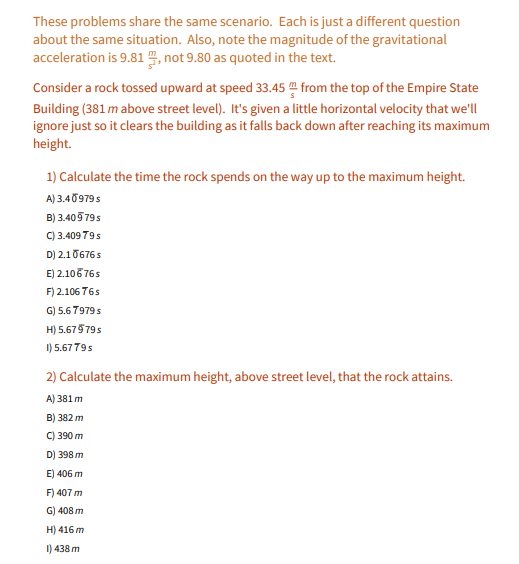These problems share the same scenario. Each is just a different question about the same situation. Also, note the magnitude of the gravitational acceleration is 9.81 5, not 9.80 as quoted in the text. Consider a rock tossed upward at speed 33.45 from the top of the Empire State Building (381 m above street level). It's given a little horizontal velocity that we'll ignore just so it clears the building as it falls back down after reaching its maximum height. 1) Calculate the time the rock spends on the way up to the maximum height. A) 3.40979s B) 3.405 795 C) 3.409 79s D) 2.10676s E) 2.10676s F) 2.106 765 G) 5.67979s H) 5.675 79s )5.6779s 2) Calculate the maximum height, above street level, that the rock attains. A) 381 m B) 382 m C) 390 m D) 398 m E) 406 m F) 407 m G) 408 m H) 416 m I) 438 m
These problems share the same scenario. Each is just a different question about the same situation. Also, note the magnitude of the gravitational acceleration is 9.81 5, not 9.80 as quoted in the text. Consider a rock tossed upward at speed 33.45 from the top of the Empire State Building (381 m above street level). It's given a little horizontal velocity that we'll ignore just so it clears the building as it falls back down after reaching its maximum height. 1) Calculate the time the rock spends on the way up to the maximum height. A) 3.40979s B) 3.405 795 C) 3.409 79s D) 2.10676s E) 2.10676s F) 2.106 765 G) 5.67979s H) 5.675 79s )5.6779s 2) Calculate the maximum height, above street level, that the rock attains. A) 381 m B) 382 m C) 390 m D) 398 m E) 406 m F) 407 m G) 408 m H) 416 m I) 438 m
University Physics Volume 1
18th Edition
ISBN:9781938168277
Author:William Moebs, Samuel J. Ling, Jeff Sanny
Publisher:William Moebs, Samuel J. Ling, Jeff Sanny
Chapter13: Gravitation
Section: Chapter Questions
Problem 88CP: Find the Hohmann transfer velocities, vEllipseEarth and vEllipseMars ,needed for a trip to Mars. Use...
Related questions
Question
If you could please do 1 and 2

Transcribed Image Text:These problems share the same scenario. Each is just a different question
about the same situation. Also, note the magnitude of the gravitational
acceleration is 9.81 , not 9.80 as quoted in the text.
Consider a rock tossed upward at speed 33.45 from the top of the Empire State
Building (381 m above street level). It's given a little horizontal velocity that we'll
ignore just so it clears the building as it falls back down after reaching its maximum
height.
1) Calculate the time the rock spends on the way up to the maximum height.
A) 3.40979s
B) 3.409 795
C) 3.409 79s
D) 2.10676s
E) 2.10676s
F) 2.106 765
G) 5.6 7979 s
H) 5.67579s
I) 5.6779s
2) Calculate the maximum height, above street level, that the rock attains.
A) 381 m
B) 382 m
C) 390 m
D) 398 m
E) 406 m
F) 407 m
G) 408 m
H) 416 m
I) 438 m
Expert Solution
This question has been solved!
Explore an expertly crafted, step-by-step solution for a thorough understanding of key concepts.
This is a popular solution!
Trending now
This is a popular solution!
Step by step
Solved in 2 steps

Knowledge Booster
Learn more about
Need a deep-dive on the concept behind this application? Look no further. Learn more about this topic, physics and related others by exploring similar questions and additional content below.Recommended textbooks for you

University Physics Volume 1
Physics
ISBN:
9781938168277
Author:
William Moebs, Samuel J. Ling, Jeff Sanny
Publisher:
OpenStax - Rice University

Classical Dynamics of Particles and Systems
Physics
ISBN:
9780534408961
Author:
Stephen T. Thornton, Jerry B. Marion
Publisher:
Cengage Learning

Principles of Physics: A Calculus-Based Text
Physics
ISBN:
9781133104261
Author:
Raymond A. Serway, John W. Jewett
Publisher:
Cengage Learning

University Physics Volume 1
Physics
ISBN:
9781938168277
Author:
William Moebs, Samuel J. Ling, Jeff Sanny
Publisher:
OpenStax - Rice University

Classical Dynamics of Particles and Systems
Physics
ISBN:
9780534408961
Author:
Stephen T. Thornton, Jerry B. Marion
Publisher:
Cengage Learning

Principles of Physics: A Calculus-Based Text
Physics
ISBN:
9781133104261
Author:
Raymond A. Serway, John W. Jewett
Publisher:
Cengage Learning

Stars and Galaxies (MindTap Course List)
Physics
ISBN:
9781337399944
Author:
Michael A. Seeds
Publisher:
Cengage Learning